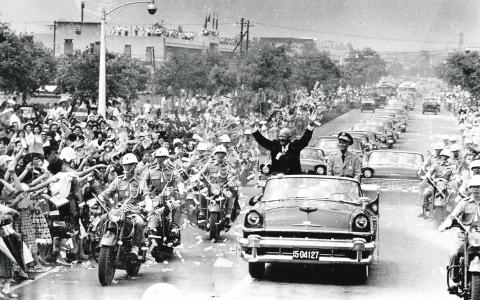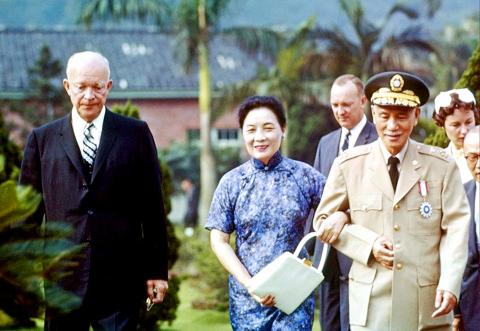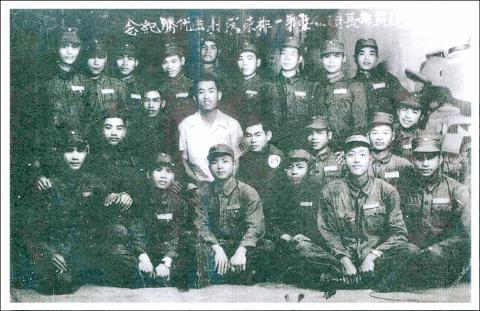June 17 to June 23
Even though Dwight D. Eisenhower was visiting Taiwan, the Chinese Communist Party made the first gesture of hospitality toward the US president — with a show of violence.
A day before the cheering crowd congregated outside of Taipei’s Songshan Airport to await Eisenhower’s arrival on June 18, 1960, the People’s Liberation Army (PLA) fired more than 30,000 shells at the offshore island of Kinmen as an official “welcoming.” They struck again just after midnight with almost twice the firepower. Eisenhower only stayed in Taipei for a day, and on June 19 the PLA staged a “send-off” by heavily shelling Kinmen once again.

Photo courtesy of Wikimedia commons
According to government statistics, the attacks killed a total of seven soldiers and wounded 59, while six civilians perished with 15 injured. No military facilities were damaged, although the blasts affected nearly 200 homes, five schools and a hospital.
Authorities in Taiwan waited until Eisenhower’s departure to retaliate, and the PLA would soon resume its scheduled shelling of Kinmen on odd-numbered days until 1979 when the US broke ties with Taiwan for China. Eisenhower would remain the only US president to ever visit Taiwan.
THE OFFSHORE ISLANDS DILEMMA

Photo courtesy of Wikimedia commons
The Chinese reaction to Eisenhower’s visit had been the most aggressive since the 823 artillery bombardment (八 二 三炮戰) in 1958, also known as the Second Taiwan Strait Crisis. He was a popular man in Taiwan; when hostilities between Taiwan and China resumed in 1953, Eisenhower signed the Sino-American Mutual Defense Treaty of 1954, which covered Taiwan and Penghu but not Kinmen or Matsu, as well as the Formosa Resolution of 1955, which authorized the US to defend Taiwan against Chinese invasion.
Eisenhower’s motives can be gleaned through several letters he wrote to then-UK prime minister Winston Churchill, who seemed to believe that China would be content by taking Kinmen and Matsu, and its vow of invading Taiwan nothing more than a bluff. Eisenhower was convinced that China would threaten the rest of East Asia and Oceania if it took Taiwan, comparing the country to Germany and Japan during World War II if left unchecked.
Eisenhower’s main dilemma was how to discern, in the event of a Chinese attack of Kinmen and Matsu, whether the PLA was just planning to take those islands or launch a full-scale invasion of Taiwan. Ideally, he wanted Chiang to evacuate most of his troops and civilians from Kinmen and Matsu so that any move by the PLA would be directed toward Taiwan, but Chiang refused. Eisenhower was disappointed, but later wrote in his biography that he would have done the same if he were Chiang.

Photo: Wang Chun-chi, Taipei Times
The US did not directly interfere in the 1958 crisis but provided support in supplies and military equipment, which fulfilled Eisenhower’s goal of standing his ground but not participating in battle.
The offshore islands issue was a subject of one of the presidential debates in October 1960 between Richard Nixon and John F. Kennedy; Kennedy believed in only protecting Taiwan and Penghu, while Nixon stated that any attack on the offshore islands would be a prelude to conquer Taiwan.
“Now what do the Chinese Communists want? They don’t want just [Kinmen] and Matsu; they don’t want just Formosa; they want the world,” Nixon argued.

Photo courtesy of Wikimedia commons
Kennedy stated that while he would do anything to defend Taiwan and Penghu, he quoted Admiral Harry Yarnell, who once said that “Kinmen and Matsu were “not worth the bones of a single American.”
Ironically, Nixon became the first US president to visit Communist China in 1972, which marked the beginning of thawing relations between the two countries, eventually leading to Taiwan’s diplomatic isolation.
WE LIKE IKE
About 500,000 people turned up on June 18 to catch a glimpse of the man who vowed to defend Taiwan.
“I pledge the personal assurance of America’s solidarity with you and your government in the defense of these ideals [of free world security] and in the pursuit of our common aspiration,” he said.
“The very fact that he was standing there was a symbol of American reassurance, of American defense of Taiwan,” former Taiwan representative to the US Shen Lyu-shun (沈呂巡) told The Diplomat in 2015.
Eisenhower’s Taiwan visit was just a brief stop on his world tour, which took up much of 1959 and 1960. The Free China Review (today’s Taiwan Review) printed a lengthy article about his visit, “The Chinese Like Ike.” It was largely a symbolic visit, and he spent most of his time with Chiang and his wife Soong Mei-ling (宋美齡) who greeted him at the airport.
This was Chiang and Eisenhower’s third meeting. The two first met at the Cairo Conference in 1943, and crossed paths again in Nanjing after World War II in 1946.
“In and out of the crowd, opera singers in full makeup, folklore characters on stilts, tiny tots on trucks and dragon and lion dances entertained the nation’s guest. As the motorcade reached the Zhongshan Bridge below the Grand Hotel, a chorus of 1,000 students greeted the president with a Chinese song: I Like Ike, the report stated.
Eisenhower spoke with Chiang for nearly two hours before addressing the crowd again, decrying the “warlike and tyrannical Communist regime” and promising to support Taiwan’s Republic of China government as the sole representative of China in the UN.
The two leaders had one last talk before Eisenhower departed for Okinawa, releasing a “joint communique pledging that their governments would continue to stand solidly behind the Sino-US Mutual Defense Treaty in meeting the challenge posed by the Chinese Communists in this area,” the report concluded.
In March 1969, vice-president Yen Chia-kan (嚴家淦) flew to the US to attend Eisenhower’s funeral. Taiwan’s situation would soon go downhill from there. Contrary to Eisenhower’s pledge, the US under Nixon by then wanted both China and Taiwan to be in the UN. Upon China’s admittance, however, Chiang withdrew from the UN in October 1971, and the rest is history.
Taiwan in Time, a column about Taiwan’s history that is published every Sunday, spotlights important or interesting events around the nation that have anniversaries this week.

The Directorate-General of Budget, Accounting and Statistics (DGBAS) told legislators last week that because the Chinese Nationalist Party (KMT) and Taiwan People’s Party (TPP) are continuing to block next year’s budget from passing, the nation could lose 1.5 percent of its GDP growth next year. According to the DGBAS report, officials presented to the legislature, the 2026 budget proposal includes NT$299.2 billion in funding for new projects and funding increases for various government functions. This funding only becomes available when the legislature approves it. The DGBAS estimates that every NT$10 billion in government money not spent shaves 0.05 percent off

Dec. 29 to Jan. 4 Like the Taoist Baode Temple (保德宮) featured in last week’s column, there’s little at first glance to suggest that Taipei’s Independence Presbyterian Church in Xinbeitou (自立長老會新北投教會) has Indigenous roots. One hint is a small sign on the facade reading “Ketagalan Presbyterian Mission Association” — Ketagalan being an collective term for the Pingpu (plains Indigenous) groups who once inhabited much of northern Taiwan. Inside, a display on the back wall introduces the congregation’s founder Pan Shui-tu (潘水土), a member of the Pingpu settlement of Kipatauw, and provides information about the Ketagalan and their early involvement with Christianity. Most

The People’s Republic of China (PRC) was out in force in the Taiwan Strait this week, threatening Taiwan with live-fire exercises, aircraft incursions and tedious claims to ownership. The reaction to the PRC’s blockade and decapitation strike exercises offer numerous lessons, if only we are willing to be taught. Reading the commentary on PRC behavior is like reading Bible interpretation across a range of Christian denominations: the text is recast to mean what the interpreter wants it to mean. Many PRC believers contended that the drills, obviously scheduled in advance, were aimed at the recent arms offer to Taiwan by the

It is a soulful folk song, filled with feeling and history: A love-stricken young man tells God about his hopes and dreams of happiness. Generations of Uighurs, the Turkic ethnic minority in China’s Xinjiang region, have played it at parties and weddings. But today, if they download it, play it or share it online, they risk ending up in prison. Besh pede, a popular Uighur folk ballad, is among dozens of Uighur-language songs that have been deemed “problematic” by Xinjiang authorities, according to a recording of a meeting held by police and other local officials in the historic city of Kashgar in